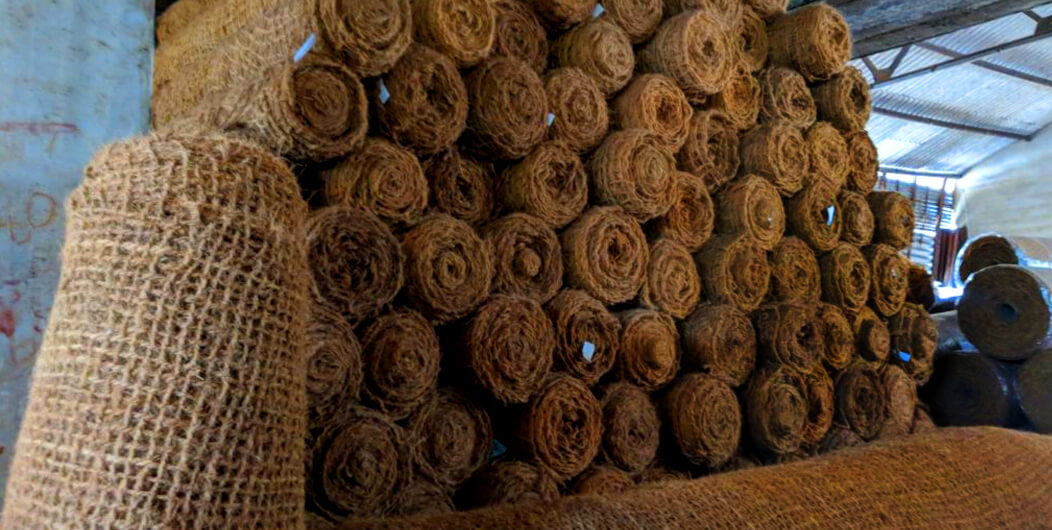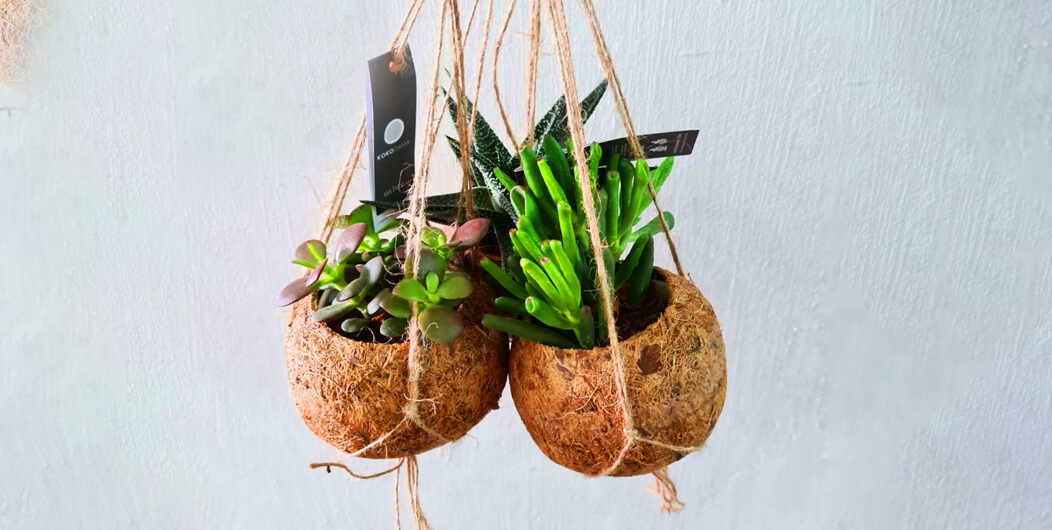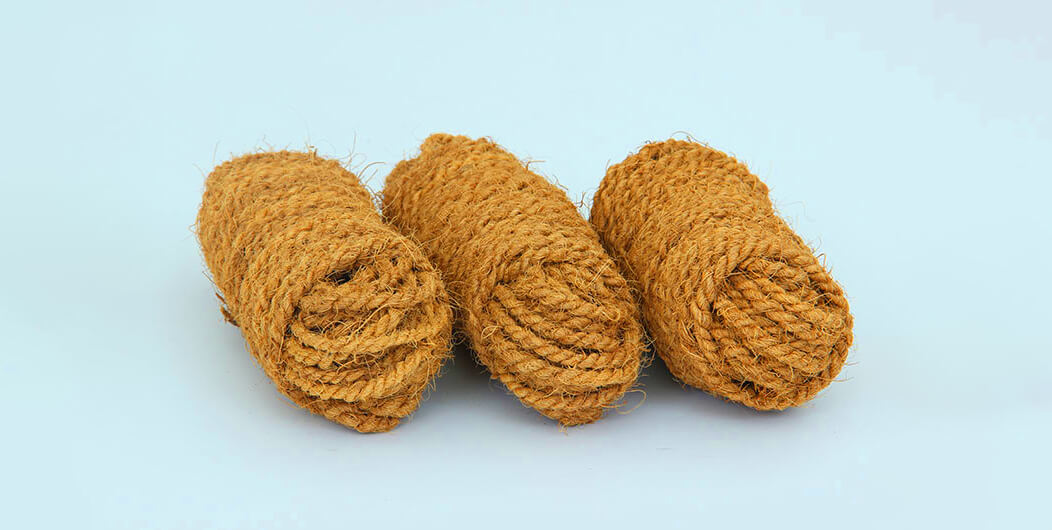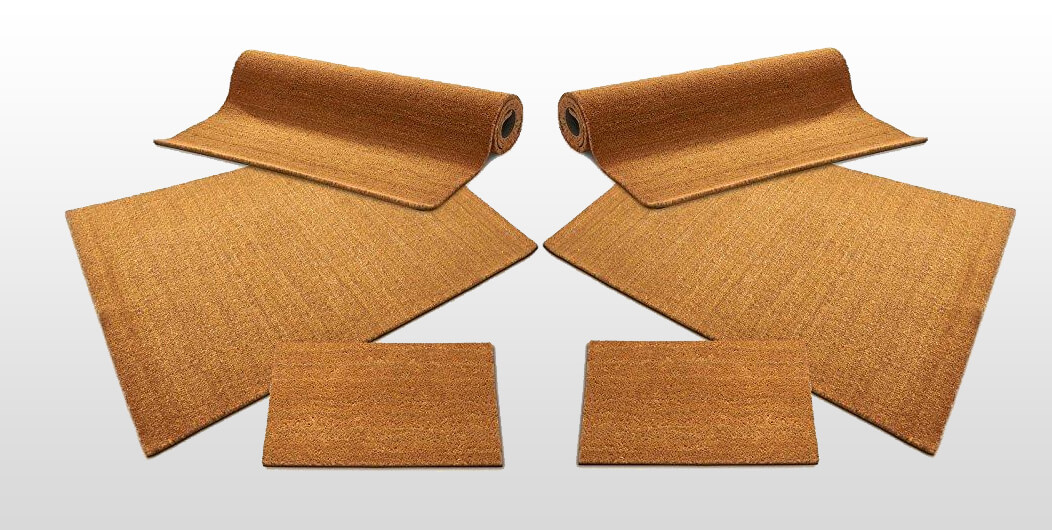
| Coir Brooms and Brushes | Coir Geotextiles | Kokedama |
| Coir Twine & Ropes | Coir Mats |
The fibre extracted from the “Mesocarp” or the outer layer of the coconut, coir fibre is the longest natural fibre as well as the strongest in terms of twist resistance. Sri Lanka has a history of using coconut fibre to manufacture a wide range of products for home, agriculture and industrial purposes.
The Sri Lankan coconut coir and coir-based product manufacturers have been a major cottage industry in Sri Lanka for centuries. The unique technique is known as the ‘drum system’ is used to extract fibre, producing long pure fibre, mostly suitable for the brush industry. It falls into two main categories; brown and white fibre, which contributes to 80% and 20% respectively of the world coir fibre demand.
Today the coconut coir product industry includes large corporations as well as SMEs producing a range of agricultural, household, and industrial products for the global market.

Sri Lankan coir manufacturers specialise in producing various types of natural coco fibre brushes and brooms with long bristle fibre produced through the Ceylon drum pair system, which gives them an edge over the other fibre manufacturers in the region.
Whereas the majority of Sri Lanka's coco fibre product manufacturers depend on smallholders and home-based industries for procuring coir fibre, Sri Lanka's brush manufacturers are medium-level producers employing a permanent army of workers with specialised skills in coir processing and brush manufacturing.
Today a handful of Sri Lankan brush and broom manufacturers, who have been mastering the art of producing quality natural fibre brushes with coconut and Palmyrah fibres for decades, backed by the modern carpentry units and great workmanship, have embarked on a journey to capture North American, European, Middle East and Japanese markets.
Sri Lanka produces a range of brushes for the global market including deck brush, floor brush, bannister brushes, flat brush, half-round brush, mixed fibre masonry brush, hand scrubs, bottlebrush, Tawashi brush, toilet brush, window wash brush, Tar brushes, street brush, squeegee, boot scrapers and a range of customised brushes for industrial requirements.
In addition, the country also exports a range of brooms designed for outdoor and indoor purposes to the global market.
With their production process and raw materials certified by ISO 9001, 14001 procedure, most of these producers manufacture a large range of brushes and brooms to cater to the diverse cleaning and sweeping requirements of the global market.
Although the market for brushes and brooms are largely made out of natural fibre sources such as coconut and Palmyrah, they have been under the constant threat of rapidly expanding plastic and other artificial fibre markets.
The growing concerns over the deleterious effects on the environment caused by synthetic fibres have given Sri Lanka's natural coir broom and brush manufacturers a distinct advantage in the global brush and broom markets.
Also, coir's eco-friendly characteristics combined with fresh and sea water-resistant qualities make it the ideal cleaning material that can be paired with any detergent or cleaning agent on any given surface or location. The fine-combed natural bristles are perfectly cut for cleaning rough or soft surfaces of grit and dirt without rough scratching or bruises and provides easy cleaning at home, garden or the workplace.

Another notable coir-based product you can source from Sri Lanka is coir geotextile which is increasingly used for bioengineering in civil infrastructure projects. Coir geotextile is a blanket made out of coir fibre.
It is widely used to prevent soil erosion on the road and railway embankments, riverbanks, leisure grounds and in industrial areas as well as in cultivation areas.
Coir geotextiles have the mechanical strength required to hold soil in place and prevent erosion. The nettings break up the runoff and dissipate the energy of flowing water. The coir geotextile replaces polymer fabric such as Polypropylene, Polyester and Nylon, etc. reducing its impact on the environment. On top of being 100% organic and biodegradable, coir also provides an ecological niche for the establishment of new vegetation by absorbing water and preventing drying out of the topsoil and seeds.
Geotextiles are anchored into place to provide a continuous sheet over the exposed slope or surface. This sheeting reduces raindrop impact, runoff velocity and surface erosion on disturbed soils. It also protects new vegetation and induces the growth and establishment of vegetation by blocking the evaporation of soil moisture.
Sri Lankan Coir geotextiles manufacturers produce both woven and non-woven varieties for bioengineering, including:
Here are a few good reasons to go for coir geotextile.
Here are a few common applications of geotextile among hundreds of others.

Kokedama is the Japanese art of growing plants in a moss-covered ball of soil wrapped with string or mono-filament fishing line. They can be displayed on a decorative surface or hung by a string in a window. There is something inherently inviting and soothing about the form of Kokedama through the juxtaposition of its controlled and wild aspects. It is a manifestation of wabi-sabi or the Japanese art of discovering beauty in imperfection. All the elements which keep bonsai from fading into oblivion are also present in kokedama but a much more accessible format.
Kokedama is the Japanese art of growing plants in a moss-covered ball of soil wrapped with string
Kokedama evolved from the Nearai style of bonsai, which includes exposed roots as part of the aesthetic. Normally they are grown in a pot for such a long period that their roots fill the pot, and they can be removed and displayed without harming the tree. To stop the roots from drying during the transformation or root-ageing process, moss is placed over the roots to cover and protect them.
In coco fibre kokedama, green moss that covers the roots is replaced by a coir ball, which takes but a fraction of the maintenance efforts that green moss calls for; for instance, green moss tends to dry unless it’s watered as many as three times a week while coir fibre only needs to be watered once a week. Thus, coco fibre kokedama is a great way to deck out a home, cafe, restaurant, or public establishment without requiring a lot of maintenance efforts and resources.
The main difference, though, between a pot and a kokedama is the way the roots respond. In a pot, the roots always encounter water, so they continue to grow. In a Kokedama, however, the roots which come to the outside of the ball encounter air. If the air is dry, the roots stop growing. Instead of using long, fat roots to explore for water, the plant grows many fine roots within the ball.
Kokedama houseplants dissolve dangerous chemicals in the air such as benzene and transform carbon dioxide into life-giving oxygen. This can lead to increased concentration and productivity (between 10% -15% increase as the findings of multiple research studies reveal).

Sri Lanka is known across the globe for the production of brown coir fibre. In its raw form, brown fibre is used extensively in numerous industries both locally and internationally. It’s favoured due to its physical properties such as length, resistance to decay, hygroscopic properties, colour & texture and mechanical properties such as elasticity, strength, torsion rigidity & elongation.
Manufactured of coir bristles extracted from Coconut fibre, coir twine is an entirely natural product that has a breaking strength of up to 100lbs depending on the thickness. Coir twine is mainly 2 ply and 3 plies with thickness ranging from 3.5mm up to 12mm depending on the application.
It’s spun from coir fibre both by hand and by spinning machines. Coir twine from Sri Lanka is in great demand owing to its attributes like optimum quality and natural properties. It’s graded according to the type of fibre used, the nature of twist and diameter, etc and widely used in various industrial and agricultural applications. Coir ropes are made of coir bristles. They are used to tether animals, secure loads and as webbing for beds.
Coir twine from Sri Lanka has a whole range of agricultural and industrial applications that include the following.
Hop is a twining vine (Humulus lupulus). Coir twine is used for stringing Hop and other vines to train them up, which supports and allows them to gain better growth. It is a fact that usage of coir twine enhances the yield of hop fruit and relatively less labour is required to grow and guide the hop plant, as the plant itself grows along the twine aided by its hairiness.
Coir twine in the domestic and horticulture industry has multiple uses including fence making, pot hanging, clotheslines, tying up plants and many other related applications thanks to their unique features such as high tensile strength, flexibility, low cost, and biodegradability.
Sea pineapple is a variety of edible sea squirt which is a popular delicacy in South Korea. Commercial cultivation of these sea squirts needs a suitable medium. Aqua twine nets made in Sri Lanka serve this purpose well. Also, custom-made aqua twine nets with 90% hair removed are used to nurture the baby oysters. The number of baby oysters that can hang along per inch of hair-removed twine is significantly higher.
Coir twine, with its superior roller resistant properties and the ability to withstand high abrasion which drives its durability, is the perfect material for wall-to-wall floor coverings. Using coir twine for tufted and woven carpets gives a better brushing effect. Its capacity for soaking up moisture and ability to add custom colours and flexibility in blending with other natural and synthetic materials lend it a unique edge in quality and comfort.

Sri Lankan coir-based product manufacturers have been producing trendy coir mats for both export and the local markets. Coir mats and carpets are particularly important today because more and more emphasis is placed on the need for embracing an eco-friendly lifestyle or going green as it’s simply called.
Sri Lanka is the fourth largest exporter of fresh and dried coconut products in the world with popular exports including desiccated coconut, brown fibre, virgin coconut oil, and coconut water which are available through a number of exporters.
Coconut & Coconut based Products
Info
Directory
eMARKETPLACE
Coconut Peat Products
Directory
eMARKETPLACE
Coconut Ekel products
Directory
eMARKETPLACE
Coconut Water Products
Directory
eMARKETPLACE
Coconut Kernel Products
Directory
eMARKETPLACE
Coconut Fiber Products
Directory
eMARKETPLACE
Coconut Shell Products
Directory
eMARKETPLACE